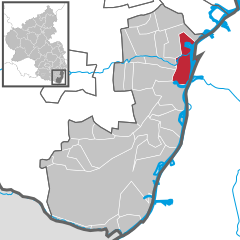Germersheim
Germersheim | |
|---|---|
Location of Germersheim within Germersheim district  | |
| Country | Germany |
| State | Rhineland-Palatinate |
| District | Germersheim |
| Government | |
| • Mayor | Marcus Schaile (CDU) |
| Area | |
| • Total | 21.40 km2 (8.26 sq mi) |
| Elevation | 105 m (344 ft) |
| Population (2022-12-31)[1] | |
| • Total | 21,099 |
| • Density | 990/km2 (2,600/sq mi) |
| Time zone | UTC+01:00 (CET) |
| • Summer (DST) | UTC+02:00 (CEST) |
| Postal codes | 76726 |
| Dialling codes | 07274 |
| Vehicle registration | GER |
| Website | www.germersheim.de |
Germersheim is a town in the German state of Rhineland-Palatinate, of around 20,000 inhabitants. It is also the seat of the Germersheim district. The neighboring towns and cities are Speyer, Landau, Philippsburg, Karlsruhe and Wörth.
Coat of arms
The coat of arms features a golden crowned eagle on a blue background. The eagle derives from the fact that, at one time the town was ruled directly by the emperor of Germany.
History
After his invasion of Gallia, Gaius Iulius Caesar made the Rhine river the border between the Roman Empire and Germania. Some small areas east of it were later invaded and added to the Roman province of Agri Decumates. As it was attacked more and more it was given up in the second half of the third century and a military camp was founded, named "Vicus Iulii" ("Village of Julius/Julius' Village). It was supported up to the fourth century.
The first record of the name "Germersheim" is from 1090, when it was named in the Sinsheimer Chronik (Chronicle of Sinsheim). The German King Rudolph von Habsburg (Rudolf of Habsburg) gave Germersheim city rights in 1276 (18 August). There is a legend which says that he, as a sick man, rode from Germersheim to Speyer to die there and not in Germersheim.
In 1325 the town was given to the Electorate of the Palatinate by King Ludwig IV. It got a higher status in the following centuries. A Catholic Order founded a monastery in 1298 which it used up to 1527.
- Having been nearly destroyed in the times of the plague and the Thirty Years' War Germersheim was burned down by French troops in 1674. Only the crypt and the foundations of the Catholic Church survived.
Still strategically important during the French Revolutionary Wars, in July 1793 Germersheim was the scene of a significant French defeat when an Austrian army under the veteran Field Marshal von Wurmser defeated a French army under Beauharnais.[2]
- From the year 1797, Germersheim belonged to France, incorporated into the newly created Mont-Tonnerre department in 1798. It was conquered by Bavarian troops in 1814. After being retaken in 1814, Germersheim's Bavarian rulers started to build a fortress in 1831. It was completed in 1855, although excavations for underground passages continued until 1861. By this time, however, the fortress had become outdated, as artillery had improved greatly in the thirty years since work began. The fortress was destroyed in 1921/22 as a result of the Treaty of Versailles. Some parts still exist, such as the "Fronte Beckers", where the town's Music School is today.
- Germersheim was the scene of several conflicts between French troops and German veteran associations during the occupation of the Rhineland following the First World War.
General Hans Graf von Sponeck, who ordered the retreat of his troops from Kerch because they were going to be hopelessly cut off by the Russian landings at Theodosia, on the Crimean Peninsula, and against express instruction of his superior officer in the winter 1941, was interned here in the fortress after Hitler had commuted his death sentence to six years detention. In the purge following the failed assassination attempt on Hitler Graf Sponeck, although not involved, was shot. Today, a street in Germersheim is named Hans Graf Von Sponeck Straße in his honour.



Local council
| Seat distribution in the town council (2014) | ||
|---|---|---|
| Party | Percentage | Number of seats |
| CDU | 40.8 | 15 |
| SPD | 20.3 | 7 |
| FWG | 19.7 | 7 |
| REP | 5.6 | 2 |
| FDP | 3.1 | 1 |
| B90/Grüne | 10.6 | 4 |

Honorary citizen
- Karl Schmitt-Walter (1900-1985), opera singer
- Eduard Orth (1902-1968), politician (CDU), Education minister of the state of Rhineland-Palatinate 1956 - 1967
Sons and daughters of the town
- Otto Freiherr Kreß von Kressenstein (1850–1929), Bavarian general and War Minister
- Paul Josef Nardini (1821-1862), theologian
- Eugen von Zimmerer (1843-1918), Governor of Cameroon and minister
- Friedrich Kreß von Kressenstein (1855-1920), Bavarian General of the Infantry
- Hermann Kriebel (1876-1941), German officer, Freikorpsführer, diplomat and NSDAP politician
- Friedrich Krebs (1894-1961), lawyer and politician (NSDAP)
- Franz Sondinger (1896-1939), director, actor, director and writer
- Karl Schmitt-Walter (1900-1985), opera singer
- Franz Immig (1918-1955), soccer player
- Lothar Fischer (1933-2004), German sculptor
References
- ^ "Bevölkerungsstand 2022, Kreise, Gemeinden, Verbandsgemeinden" (PDF) (in German). Statistisches Landesamt Rheinland-Pfalz. 2023.
- ^ The Century Cyclopaedia of Names, coordinated by Benjamin E Smith and published by the De Vinne Press, New York 1894 (Page 434)



